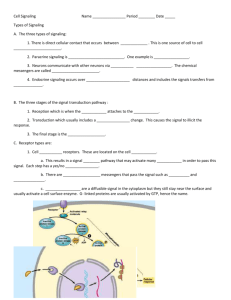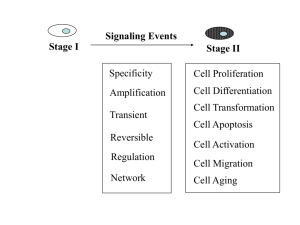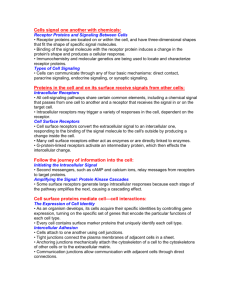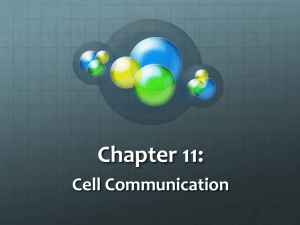Lecture 12
advertisement
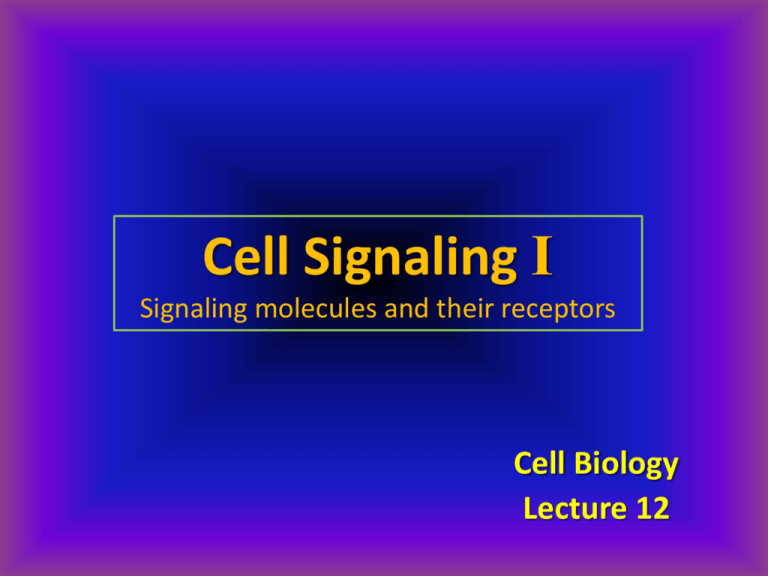
Cell Signaling I Signaling molecules and their receptors Cell Biology Lecture 12 Readings and Objectives • Reading – Russell Chapter 8 (not sufficient) – Cooper: Chapter 15 • Topics Lecture 12 • Signaling Molecules and Their Receptors • Functions of Cell Surface Receptors Lecture 13 • Pathways of Intracellular Signal Transduction • Signal Transduction and the Cytoskeleton • Signaling Networks 2 Cell Signaling Introduction • regulate virtually all aspects of cell behavior – Cell proliferation, metabolism, organellar and cell movement, apoptosis, etc • Modes of cell signaling – Direct cell-cell signaling—direct interaction of a cell with its neighbor – Signaling by secreted molecules—signals are transmitted over distant cells – signaling molecules from one cell bind to receptors on other cells – range in complexity from simple gases to proteins 3 Signaling by secreted molecules • Endocrine signaling—signaling molecules (hormones), target cells at distant body sites Example: estrogen. • Paracrine signaling—act on neighboring target cells, e.g., neurotransmitters • Autocrine signaling—respond to self signaling molecules – T lymphocytes: proliferation in response to cytokines produced by the same cell 4 Animation: Types of Signaling 5 Signaling molecules • Classes of signaling molecules 1. Hydrophobic signaling molecules o Use nuclear receptors 2. Neurotransmitters 3. Peptide signaling molecuels 4. Eicosanoids – 2 through 4 use membrane receptors 6 1. Hydrophobic signaling molecules • Passively diffuse across cell membrane – Steroid hormones – Vitamin D3 – Thyroid hormone – Retinoid acid – Nitric oxide and CO • All use intracellular receptors • function as activators or repressors of genes 7 2. Neurotransmitters • carry signals between neurons, from neurons to other target cells • hydrophilic, can’t cross the plasma membrane of target cells; bind to cell surface receptors • receptors ligand-gated ion channels • Neurotranmitter binding opens the channels 8 3. Peptide signaling molecules • Peptide hormones • Neuropeptides • polypeptide growth factors – Short polypeptides, one or more chains – Variety of functions • All use cell membrane anchored receptors 9 4. Eicosanoids: lipid signaling molecules • Eicosanoids: lipid signaling molecules which include prostaglandins, prostacyclin, thromboxanes, and leukotrienes • Arachindonic derived from phospholipids, by phospholypase A2 10 4. Peptide signaling molecules • Cyclooxygenases catalyse the conversion (targets for antiinflammatory drugs) • Short lived, thus act in autocrine or paracrine pathways • Platelet aggregation, inflammation, smooth muscle contraction 11 Signaling Receptors Two types • Intracellular receptors: include nuclear receptor family – bind hydrophobic signaling ligands – Conformation change, translocate to nucleus – Act as transcriptional activators or repressors to regulate gene expression – Signal does not amplify • Membrane integral receptors: – Bind non-hydrophobic signaling ligands – Conformational change activates a phospho-relay cascade through kinases; might rely on secondary signaling molecules – Exponential signal amplification through kinase cascade – Targets: transcription, replication, translation, cytoskeleton 12 remodeling, metabolic modulation, etc. Animation: Signal amplification 13 Intracellular receptors: Nuclear Receptors Nuclear receptor superfamily • Transcription factors, have domains for – ligand binding – DNA binding – modulate transcription transcriptional activators or repressors • Glucocorticoid receptor: bound to Hsp90 chaperones in the absence of hormone • Glucocorticoid binding displaces Hsp90; binds the regulatory DNA sequences together with HAT coactivator (Histon acetyl transferase) 14 Intracellular receptors: Nuclear Receptors Thyroid hormone • Hormone binding may alter the activity of the receptor: • In the absence of hormone • hormone receptor is associated with a corepressor complex (HDAC) • No transcription of target genes • Hormone binding, • replaces HDAC with HAT (activator) • Transcription is activated 15 Membrane receptors: G-protein coupled receptros • largest family of cell surface receptors • seven membrane-spanning α helices • Various signaling ligands, – Hormones – neurotransmitters • Signals transmitted via guanine nucleotide-binding proteins (G proteins) • Various targets and effector proteins 16 Membrane receptors: G-protein coupled receptros • Ligand binding, conformational change, cytosolic domain activates a G protein • heterotrimeric G proteins : α, β, and γ subunits • α- binds G-nucleotides, regulate G protein activity • In inactive state, α bound to GDP in a complex with β, and γ • ligand binding causes GTP to replace GDP • The α and βγ complex then dissociate from the receptor and interact with their targets • A large array of G proteins connect receptors to distinct targets. • G proteins can also regulate ion channels 17 Animation: G-protein coupled receptors 18 Receptor Protein- Tyrosine Kinases • Humans have 59 receptor RPTK • Signaling molecules: EGF, NGF, PDGF, and other growth factors and insulin • phosphorylate their substrate proteins on tyrosine residues • Structure – N-terminal extracellular ligand-binding domain – single transmembrane α helix – a cytosolic C-terminal domain with proteintyrosine kinase activity 19 Receptor Protein- Tyrosine Kinases • Ligand-induced receptor dimerization • Ligand binding activates the cytosolic kinase domain • Autophosphorylation of receptor – increases protein kinase activity – creates binding sites for other proteins that transmit signals downstream of the activated receptors 20 Receptor Protein- Tyrosine Kinases • SH2 domains mediate binding/activation of downstream signaling molecules • Signal propagates down to final target through kinase cascade 21 Receptor Protein- Tyrosine Kinases 22 Nonreceptor protein-tyrosine kinases • Similar RPTK, but the cytosolic domains have no catalytic activity • Cytokine receptor superfamily (interleukin-2 and erythropoietin) • Cytokine receptors function in association with non-receptor protein-tyrosine kinases – Example: Janus Protein-tyrosine kinases (JAK) • Cytokines regulate development and differentiation of lymphocytes during immune response 23 Non-receptor protein-tyrosine kinases • Ligand binding induces receptor dimerization • cross-phosphorylation of the associated nonreceptor protein-tyrosine kinases • Phosphorylation of receptor cytosolic domains • Formation of binding pocket for phosphorylation of other signaling proteins in the cascade 24

